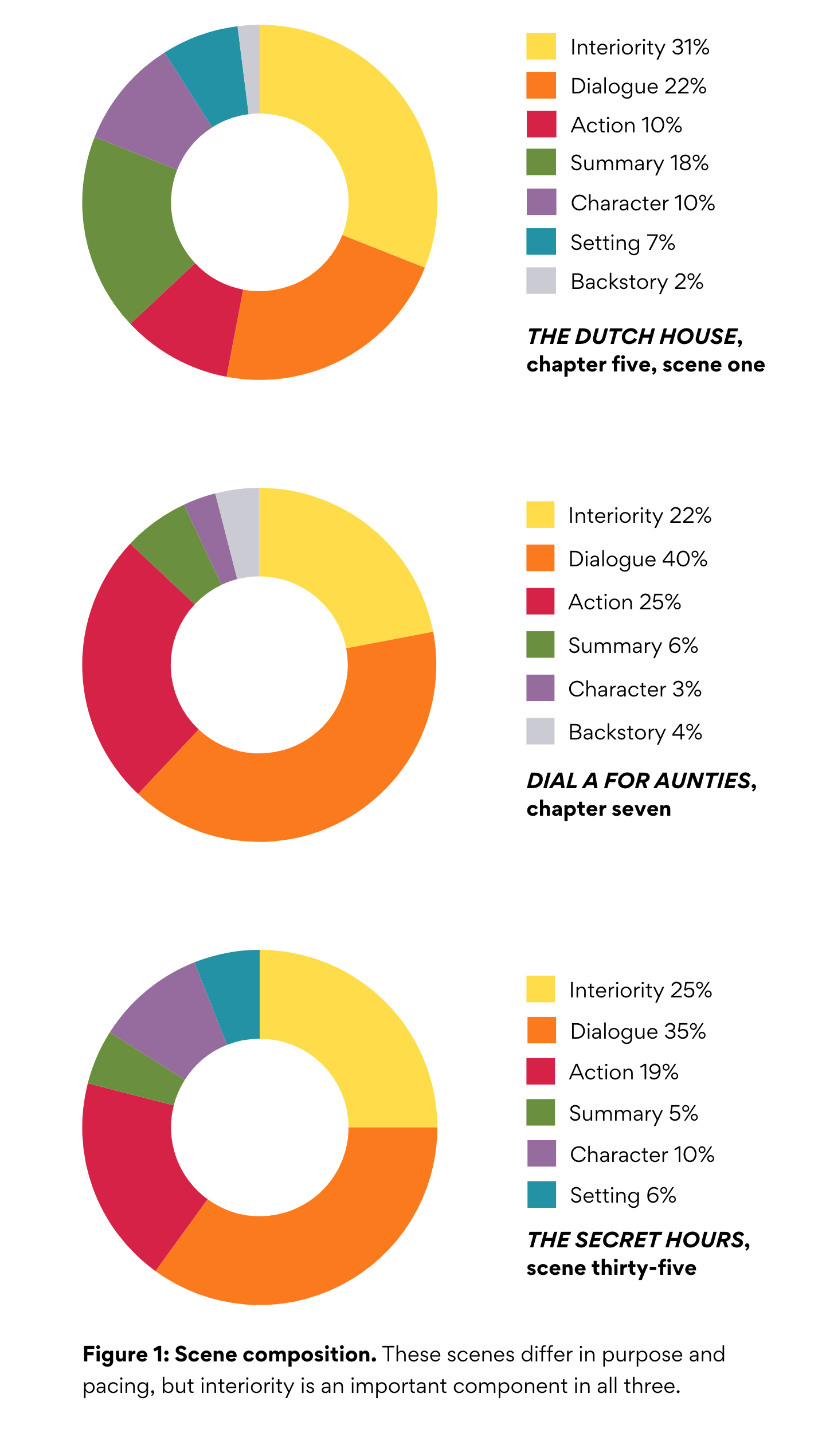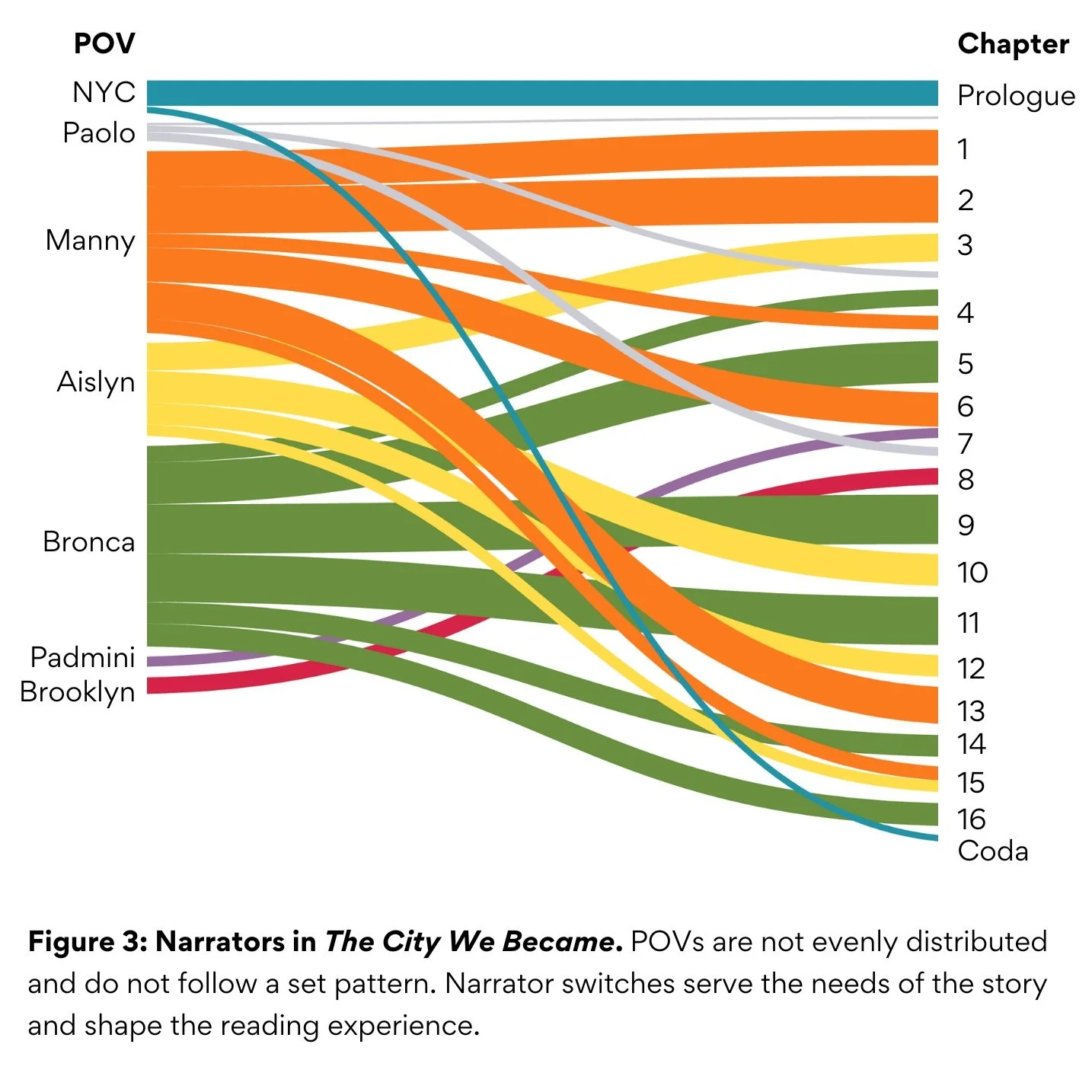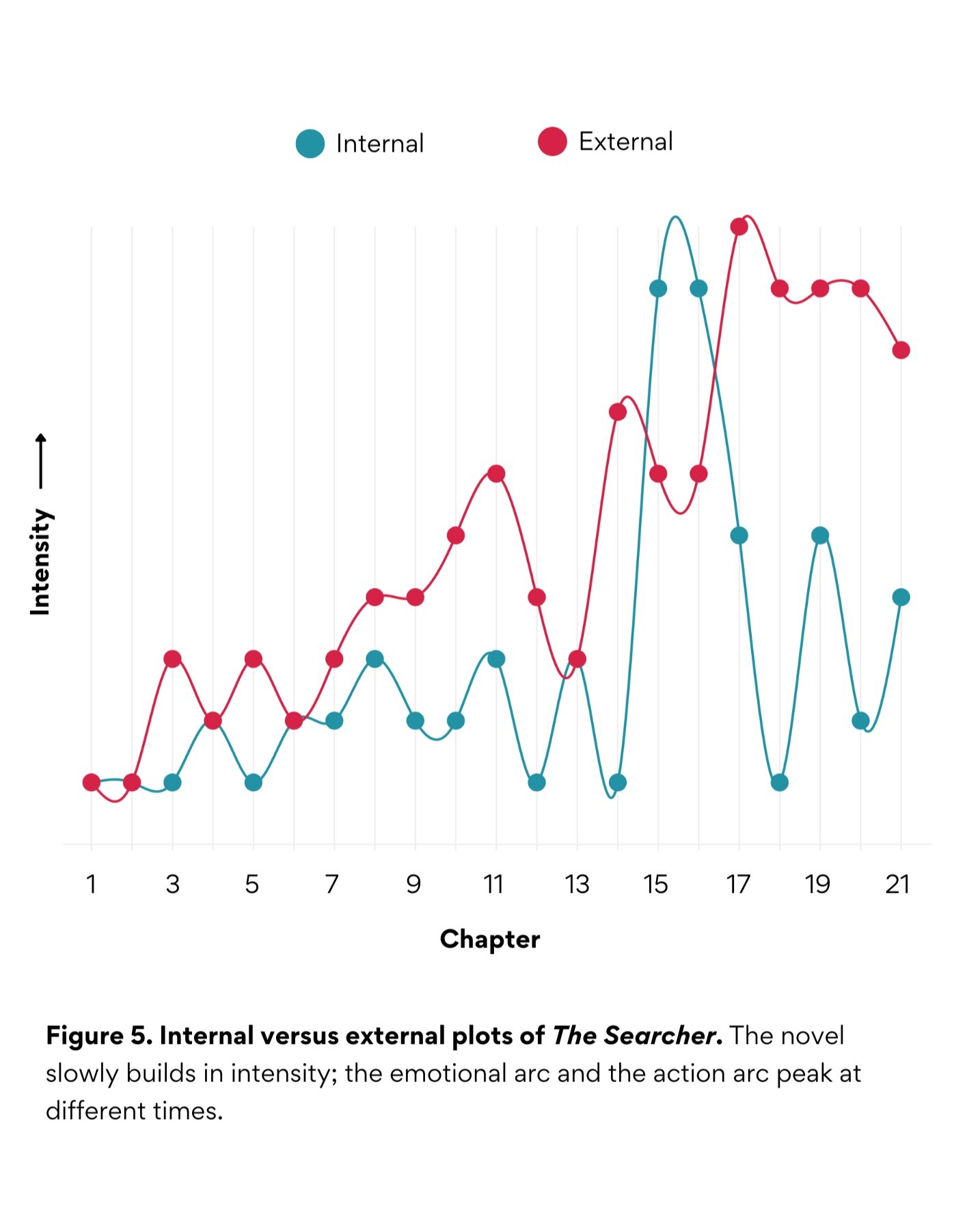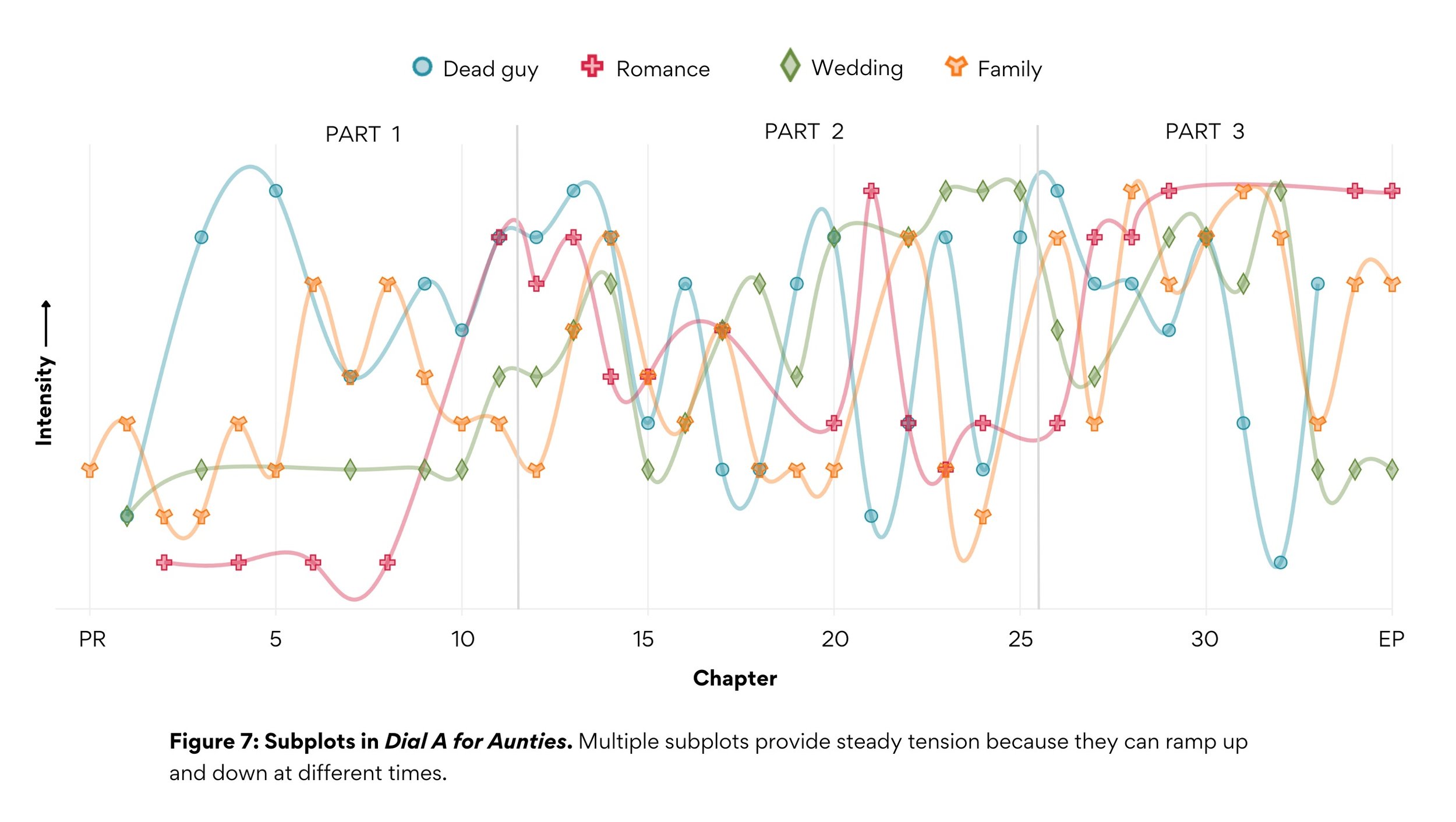Novel Study illustrations
Welcome! I hope you are enjoying Novel Study. (If you need a copy of your own, go to my store.) All of the illustrations from the book are collected here, for easy browsing and magnifying, alongside complete alt text.
Figure 1: Scene composition.
Caption: These scenes differ in purpose and pacing, but interiority is an important component in all three.
Alt text: Three donut charts comparing the composition of scenes from three novels, displaying percentages for seven literary elements: interiority, dialogue, summary, character, action, setting, and backstory. The Dutch House (chapter 5, scene 1) features 31 percent interiority, 22 percent dialogue, 18 percent summary, and smaller percentages for other elements. Dial A for Aunties (chapter 7) shows a dominance of dialogue at 40 percent, followed by action at 25 percent, and interiority at 22 percent. The Secret Hours (scene 35) balances dialogue at 35 percent, interiority at 25 percent, and action at 19 percent with lower percentages for other elements.
Figure 2: Chronology of The Dutch House.
Caption: Time jumps stoke suspense, generate dramatic irony, and underscore themes.
Alt text: A timeline graph representing the chronological progression of The Dutch House across chapters and decades. The x-axis indicates chapter numbers 1 through 20, and the y-axis displays years from the 1960s to 2000. The timeline is grouped into six broad categories, indicated by color: childhood, dispossession, young adulthood, residency & marriage, real estate & family, return & repossession. The chronology proceeds broadly in order, with the exception of a handful of scenes which jump forward or backward in time, mostly to the 1970s period.
Figure 3: Narrators in The City We Became.
Caption: POVs are not evenly distributed and do not follow a set pattern. Narrator switches serve the needs of the story and shape the reading experience.
Alt text: A Sankey graph showing the distribution of point of view (POV) chapters among several characters—NYC, Paolo, Manny, Aislyn, Bronca, Padmini, and Brooklyn—from the prologue through chapter 16 and a coda. Manny and Bronca have the most chapters, followed by Aislyn. NYC narrates only the Prologue and Coda; Paolo narrates a few scenes called Interruptions, all in the first half of the novel; and Padmini and Brooklyn narrate just one scene each, both located in the middle of the novel.
Figure 4: Plot structure of The Searcher.
Caption: The novel has an idiosyncratic structure and pacing that exists alongside a traditional three-act structure.
Alt text: A line graph depicting the plot structure of The Searcher across 21 chapters, divided into three segments: Setup, Slow Build, and Action Cascade. The intensity of the plot increases significantly towards the later chapters, peaking in the Action Cascade.
Figure 5: Internal versus external plots of The Searcher.
Caption: The novel slowly builds in intensity; the emotional arc and the action arc peak at different times.
Alt text: A dual-line graph comparing the intensity of internal and external plots across 21 chapters of The Searcher. Both plot lines rise gradually towards the last third of the novel, with the internal plot peaking in chapters 15 and 16, and the external plot peaking in chapter 17.
Figure 6: Plot structure of The Last Thing He Told Me.
Caption: Frequent high-intensity scenes are undergirded by backstory chapters.
Alt text: A line graph showing the plot intensity of The Last Thing He Told Me over 41 chapters, divided into three parts. The graph shows a regular pattern of high and low intensity chapters until the midpoint of the novel, after which point there is a steady rise in intensity that peaks in chapter 30, the last chapter of part two. Part three once again alternates high and low intensity chapters until the climax in chapter 36, after which the intensity gradually falls.
Figure 7: Subplots in Dial A for Aunties.
Caption: Multiple subplots provide steady tension because they can ramp up and down at different times.
Alt text: A long line graph showing the intensity and progression of four subplots (Dead Guy, Relationship, Wedding, Family) across the chapters of Dial A for Aunties. In Part 1, the Dead Guy plot peaks in intensity early, which the Relationship plot shows a slow build. In Part 2, all four plots show varying levels of intensity, mostly in the middle range, until they start to diverge at the end of Part 2. The Wedding plot has the highest intensity at the end of Part 2. In Part 3, all four plots quickly build in intensity; around chapters 29 and 30, the parts begin to diverge again as they are each resolved. In this part, the Relationship plot has the highest intensity until the end of the novel.
Figure 8: Chronology of Black Sun.
Caption: The first three chapters build suspense by mixing chronology, while periodic backstory chapter explain motivations.
Alt text: A timeline graph depicting the chronology and point of view (POV) shifts among characters Serapio, Xiala, Naranpa, Okoa, and Zataya in Black Sun, plotted against the timeline from 10 years before Convergence to the Convergence event. Serapio’s chapters are the only ones that dip back in time. Naranpa’s plot thread begins at Convergence before going back to the main line of the narrative, which starts at 20 days before Convergence and builds steadily until the day of Convergence.
Figure 9: Internal versus external plots of The Secret Hours.
Caption: A fast-start, high-intensity subplot balances a lower-intensity, slow-build subplot.
Alt text: Two line graphs charting the intensity of internal and external plots through the parts of The Secret Hours, following four different subplots: Max, Monochrome, Contract, and Berlin. The size of the circles representing data points is related to how much ‘page time’ each plot gets in the part. In the external plot, we can see that the Max subplot starts out with high intensity, dips lower in parts three and four, before ending at a high intensity again. The Monochrome and Berlin subplots start with lower intensity, slowly rise, and peak in intensity in parts five and six. The contract subplot has a medium level of intensity until peaking at the end. In the internal plot, the Max subplot and Monochrome subplots show a similar pattern as in the external plot, while the Contract and Berlin subplots gradually build in intensity until peaking in parts 6 and 7.
Want more Novel Study?
Read it first:
Week 1, 2024 – The wheel goes round again
Week 20 – The seesaw of ambition and deadlines
Week 38, 2024 – The psychology of publishing












